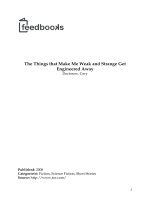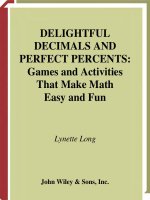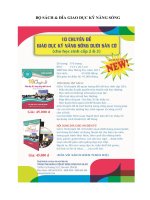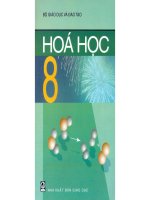Bộ sách Creative activities that make math science fun for kids Cool tessellations
Bạn đang xem bản rút gọn của tài liệu. Xem và tải ngay bản đầy đủ của tài liệu tại đây (9.91 MB, 34 trang )
-TO LIBRAR
Y
HOW
CHECKERB
OA
RD
COOL ART WITH MATH & SCIENCE
TESSELLATIONS
CREATIVE ACTIVITIES THAT MAKE MATH & SCIENCE
FUN FOR KIDS!
ANDERS HANSON AND ELISSA MANN
C O O L A R T W IT H MAT H & SCIEN CE
TESSELLATIONS
CREAT IVE A C TIVITIE S T H A T M A K E M A T H
FUN FOR KIDS!
ANDERS HANSON
&
SC I E N C E
AND ELISSA MANN
V I S IT U S AT W W W. A B DO P U B LI S H I N G.CO M
Published by ABDO Publishing Company, a division of ABDO, P.O. Box 398166, Minneapolis,
Minnesota 55439. Copyright © 2014 by Abdo Consulting Group, Inc. International copyrights
reserved in all countries. No part of this book may be reproduced in any form without written
permission from the publisher. Checkerboard Library™ is a trademark and logo of ABDO Publishing
Company.
Printed in the United States of America, North Mankato, Minnesota
062013
092013
Design and Production: Anders Hanson, Mighty Media, Inc.
Series Editor: Liz Salzmann
Photo Credits: Anders Hanson Shutterstock, [page 18] MC Escher (image ® M.C. Escher Foundation)
LIBRARY OF CONGRESS CATALOGING-IN-PUBLICATION DATA
Hanson, Anders, 1980Cool tessellations : creative activities that make math & science fun for kids! / Anders Hanson and
Elissa Mann.
pages cm. -- (Cool art with math & science)
Includes index.
ISBN 978-1-61783-826-2
1. Tessellations (Mathematics)--Juvenile literature. 2. Mathematical recreations--Juvenile literature.
3. Creative activities and seat work--Juvenile literature. I. Mann, Elissa, 1990- II. Title.
QA166.8.H36 2013
516’.132--dc23
2013001903
C O NT E NT S
4
6
8
11
12
13
14
18
COOL TESSELLATIONS
THE TILING OF SPAC E
SHAP E U P!
GET TO KNOW YOUR P OLYG ON S!
P RO J ECT
1
MAKIN G A T ESSEL L AT I ON
T HREE O F A K I N D
REGULA R T ESSEL L AT I ON S
T HE G R E A T E I G H T
SEMI- REGUL A R T ESSEL L AT I ON S
ANYTH I N G G O E S !
NON- REGUL A R T ESSEL L AT I ON S
P RO J ECT
2
TESSELLAT I N G W I T H SC I SSOR S
M.C . E S C H E R
THE MAST ER OF T ESSEL L AT I ON S
19
20
24
26
30
31
31
32
M IRROR IM A GE
TH E B E AU TY O F SY MM E TRY
PROJEC T
3
TE SS E L L ATI N G W I TH TR AC I N G PA P E R
A RCH IM EDEA N S OLIDS
TE SS E L L ATI O N S O N A S P H E R E
PROJEC T
4
TE SS E L L ATI N G I N 3- D
M A TH TERM S
GLOS S A RY
W EB S ITES
INDEX
TESSELLATIONS
THE TILING OF
SPACE
T
ake a look at a bee’s honeycomb. It has interlocking shapes that seem to go
on forever! A honeycomb is one example of a tessellation. Tessellations are
designs with repeating patterns. They don’t just occur in nature. People make
them too! Tessellations are a way to fill spaces with simple or complex shapes.
4
Bees are good at making a certain kind
of tessellation. It’s called a honeycomb.
Each shape has six sides.
For centuries, artists have created
patterns with shapes. Can you name any
of the shapes in the tessellation below?
5
SHAP E U P!
GET TO KNOW YOUR POLYGONS!
A
polygon is a flat shape. Its sides are straight
lines. The sides join together at points
called vertices. For any polygon, the number of
sides and vertices are the same. For example, all
pentagons have five sides and five vertices.
SIDES
ANGLES
When two lines meet at a vertex, they form an
angle. Angles are measured in degrees.
REGULAR
POLYGONS
EQUILATERAL
TRIANGLE
VERTICES
A REGULAR PENTAGON
The length of each side is the same.
All of the angles are the same.
SQUARE
REGULAR
PENTAGON
6
REGULAR
HEXAGON
There are two main types of polygons.
They are regular and irregular polygons.
All of the sides in a regular polygon are
the same length. And all of the angles are
equal to each other. All other polygons
are irregular polygons.
SIDES
VERTICES
ANGLES
AN IRREGULAR PENTAGON
IRREGULAR
POLYGONS
TRIANGLE
If a polygon is not regular, it is an irregular polygon.
The sides and angles are not all equal.
QUADRILATERAL
PENTAGON
7
HEXAGON
8
PROJ E C T
1
MAKING A
TESSELLATION
STUFF
Y O U´L L
NEED
đƫ PENCIL
đƫ RULER
đƫ SCISSORS
đƫ CARD STOCK
đƫ COLORED PAPER
TERMS
đƫ POLYGON
đƫ EQUILATERAL
TRIANGLE
đƫ SQUARE
đƫ HEXAGON
T
here are endless designs you can use in
tessellations. A tessellation can be simple, using
only a few polygons. Or they can be complex, using
many different shapes. Start off simple. Make a
regular tessellation.
9
2
HOW TO MAKE IT
1 Draw an equilateral triangle on card
stock. Each side should be 1½ inches
(3.8 cm) long. Cut out the triangle.
You will use it as a template.
3
2
Trace the template on card stock. Then
match the left edge of the template
with the right edge of the traced
triangle. Trace the template again.
3
Repeat step 2 four more times. The
triangles will form a hexagon. Cut out
the hexagon. It is another template.
4 Draw a square on card stock. Each
side should be 1½ inches (3.8 cm)
long. Cut out the square. Now
you have three templates.
5 Trace each template ten or more times
on colored paper. Cut them out.
6
6
10
Use the shapes to create
tessellations. Arrange them in
different patterns. Fit them together
with no overlapping or gaps.
THR E E O F A K I ND
REGULAR TESSELLATIONS
S
ome tessellations are made with only one polygon. They are called regular
tessellations. Only three regular polygons can make regular tessellations.
They are the triangle, the square, and the hexagon.
REGULAR TESSELLATIONS
TRIANGLES
SQUARES
11
HEXAGONS
THE G RE AT E I GH T
SEMI-REGULAR TESSELLATIONS
A
semi-regular tessellation is made with two or more regular polygons.
There are eight kinds of semi-regular tessellations.
SEMI-REGULAR TESSELLATIONS
TRIANGLES
AND SQUARES
TRIANGLES
AND HEXAGONS
TRIANGLES, SQUARES,
AND HEXAGONS
SQUARES AND
OCTOGONS
TRIANGLES
AND SQUARES
TRIANGLES
AND HEXAGONS
TRIANGLES AND
DODECAGONS
SQUARES, HEXAGONS,
AND DODECAGONS
12
ANY T HI N G GO E S!
NON-REGULAR TESSELLATIONS
A
non-regular tessellation can be made with many shapes. Any shape can be used,
as long as the pattern repeats. Most artistic tessellations are non-regular.
NON-REGULAR TESSELLATIONS
SQUARE MOORISH TILES
WITH PRINTED PATTERN
INTERLOCKING
MOORISH TILES
13
14
PROJ E C T
2
TESSELLATING
WITH
SCISSORS
STUFF
Y O U´L L
NEED
đƫ CARD STOCK
đƫ RULER
đƫ PENCIL
đƫ SCISSORS
đƫ CLEAR TAPE
đƫ SHEET OF
WHITE PAPER
đƫ COLORED
PENCILS
TERMS
đƫ RIGHT ANGLE
đƫ VERTICAL
đƫ HORIZONTAL
T
here are many different ways to make a
tessellation. Try creating a non-regular
tessellation. When it is finished, you will have
a unique poster to hang up.
15
đƫ SQUARE
2
HOW TO MAKE IT
1 Use a ruler and pencil to
draw a 2-inch (5 cm) square
on card stock. Cut it out.
2
Label each corner of the square
with the numbers 1 through
4. Draw a horizontal squiggly
line from edge to edge. Draw
a vertical squiggly line from
edge to edge. No line should go
through a corner of the square.
3
Cut the sections apart along the
squiggly lines. Each section should
have a corner of the square.
The corners are right angles.
3
4
4 Rearrange the sections. The
four corners should meet
in the center. Tape them
together to form a template.
16
5
5
Trace the template on a
sheet of white paper.
6
Rotate the template so one edge
matches the shape you traced. Trace
the template again. Repeat until
the paper is covered. There should
be no gaps between the shapes.
7
Color the tessellation. Hang your
tessellation poster on a wall.
6
7
17
M. C. E S CHER
THE MASTER OF TESSELLATIONS
M
.C. Escher
was an
artist famous for
his tessellations.
He used geometric
shapes and
symmetry to create
much of his art.
Escher was
influenced
by geometric
tiling he saw in
Moorish palaces.
For examples of
Moorish tiles see
page 13.
18
MIRRO R IM A G E
THE BEAUTY OF SYMMETRY
S
ymmetry is an important part of making tessellations. Shapes repeated in a pattern
create symmetry. There are many different types of symmetry. Three types of
symmetry often found in tessellations are translational, rotational, and reflectional.
PATTERN SYMMETRY
Translational
The shape slides up, down, to
the sides, or diagonally while
keeping its form.
Rotational
The shape turns in a circular
direction to the right or to the
left while keeping its form.
19
Reflectional
The shape mirrors itself
onto a different part of the
tessellation.
20
PROJ E C T
3
TESSELLATING
WITH TRACING
PAPER
STUFF
Y O U´L L
NEED
đƫ 2 SHEETS OF
WHITE PAPER
đƫ RULER
đƫ PENCIL
đƫ 2 SHEETS OF
TRACING PAPER
đƫ COLORED
MARKERS
TERMS
đƫ TRANSLATIONAL
SYMMETRY
đƫ SQUARE
U
se translational symmetry to make a new
kind of tessellation! Use your imagination to
create new shapes. The weirdest shapes can make
the coolest projects!
21
1
HOW TO MAKE IT
2
1
Use a pencil and a ruler to draw
a 2-inch (5 cm) square on white
paper. Draw a squiggly line
over the top edge of the square.
Draw a squiggly line over the
right edge of the square.
2
Erase the straight lines
underneath the squiggly lines.
3
Put tracing paper over the shape.
Trace the two squiggly lines.
Slide the tracing paper to the
right. Match the empty left edge
to the right squiggly line on the
white paper. Trace the line.
3
22
4
4 Line up the two side squiggly lines
with either end of the top line on the
white paper. Trace the top line.
5 Lay a second sheet of tracing paper
over the first sheet. Trace the
shape. Remove the white paper.
6
Slide the second sheet to the right. The
left side of the shape on the second
sheet will match the right side of the
shape on the first sheet. Trace the
shape. Slide the second sheet down.
Match the top of the shape on the
second sheet to the bottom of the shape
on the first sheet. Trace the shape.
7
Repeat step 6 until the page is full. Color
in the shapes. Hang it in a window
for a stained glass tessellation.
6
7
23









